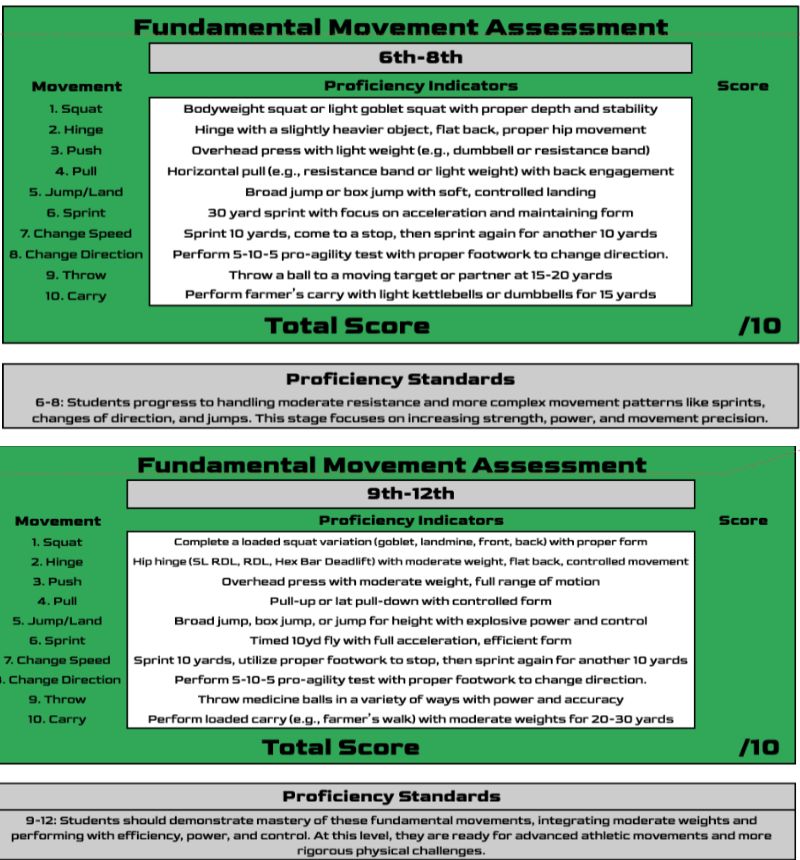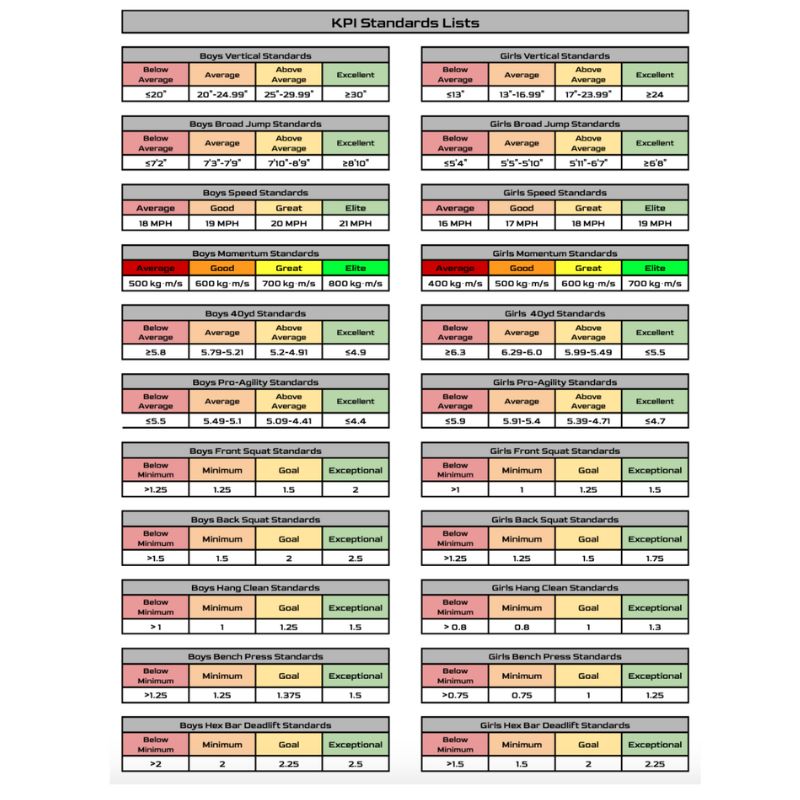As the role of physical education evolves, so too must the way we assess student progress. Traditional grading systems, which often focus on short-term performance metrics, fail to capture the broader goals of physical literacy and long-term athletic development (LTAD). A shift toward standards-based, development-focused assessments can lay the groundwork for lifelong fitness and athletic success.
This article will explore how redefined assessments, integrated across K-12 physical education, can and should be the foundation of LTAD as this would ensure vertical alignment throughout school districts. As a high school strength and conditioning coach, I have seen firsthand the impact that thoughtful assessment can have on student development. My experience working with student athletes and general population PE students has highlighted both the strengths and shortcomings of a traditional grading model in PE.
Too often, assessments prioritize short term outcomes, with one-time fitness test scores such as sprint “testing” 2-3 times per year and 1RM testing being viewed as the end-all be-all of athletic performance in physical education. Tracking meaningful progress daily in movement quality, athletic development, and physical literacy is a much better approach to consistent, measured progress through assessment in all K-12 physical education. By integrating specific key performance indicators (KPIs) rooted in long-term athletic development, we can create a system that not only benefits competitive athletes but also equips all students with the skills and confidence to lead active lives beyond the classroom.
I have had the opportunity to build a 6-12th grade strength and speed program at Wilber-Clatonia Public schools. When I took over the position, it was evident that there were a lot of gaps in understanding and application of the movement skills necessary to improve athletic development and lifelong wellness. Upon noticing these gaps, I decided to research and build out specific KPIs relevant to the training goals we were putting in place for our program. The mission statement for my strength and speed program is:
“Develop a system that provides long-term athletic development through high quality movement patterns, leading to improved strength, speed, and a reduction of injuries.”
As I began to determine what our KPI’s would be, I have kept this mission at the forefront for each decision made in our program—I’ve even told the students, if we are doing something that does not point us back to this mission, I want them to question why we are doing it.
Tracking meaningful progress daily in movement quality, athletic development and physical literacy is a much better approach to consistent, measured progress through assessment in all K-12 physical education, says @tuckplatt. Share on XThe Purpose of Assessment in Physical Education
At its core, the purpose of assessment in PE is to provide meaningful feedback to both students and teachers. This feedback should not merely reflect momentary performance, but should track the development of physical literacy—a student’s ability to perform a wide variety of movements competently and confidently.
The ultimate goal is to cultivate habits that promote lifelong fitness and athletic capability, aligning directly with the principles of LTAD.

Currently, many PE programs—including those in my area—still rely on assessments that prioritize generic fitness tests (ex. mile run, push up tests) or subjective participation grades. While these metrics offer some insight, the often fail to measure meaningful physical development. In my district, PE assessments largely consisted of standardized fitness tests administered only a few times per year. These tests often have a limited focus on skill acquisition, movement proficiency, or tracking progress over time. This traditional model does not account for individual growth or long-term athletic potential.
At its core, the purpose of assessment in PE is to provide meaningful feedback to both students and teachers. This feedback should not merely reflect momentary performance, but should track the development of physical literacy. Share on XInstead, by integrating key performance indicators (KPIs) such as sprint times, jump metrics, and relative strength measures, we can create a system that provides a clearer picture of a student’s movement competency and athletic development. This approach ensures that assessment aligns with both stat standards and LTAD principles, fostering a more effective and engaging PE experience for all students.
Why We Need to Redefine Assessment
The current PE assessment models often overlook the holistic development of students, focusing on immediate outcomes such as speed, strength, or flexibility, without considering their long-term athletic potential. Assessments should encourage personal growth, focusing on progressive improvement rather than comparative performance against peers.
By shifting toward a model that values progress, effort, and the development of foundational movement patterns, we can foster an environment where every student is prepared for lifelong athleticism.
Standards-Based Assessments: The PRIME Approach
A redefined assessment structure should be built on five core principles, summarized as the PRIME framework:
- Progress—Assessments should track student growth over time rather than focusing on static, one-time performance measures. By emphasizing progression in movement quality, strength, and speed, we can better reflect long-term athletic development.
- Realistic Goals—Goals should be developmentally appropriate and aligned with individual capabilities. Rather than setting arbitrary benchmarks, assessments should consider each student’s starting point and create achievable targets that foster confidence and motivation.
- Individualization—No two students are the same, and assessments should reflect that. By accounting for differences in biological maturity, training age, bodyweight, gender, and movement competency, we can ensure fair and meaningful evaluation for all students, not just those with natural athletic ability.
- Measurability—Assessments must be data-driven and objective, utilizing key performance indicators (KPIs) such as sprint times, jump metrics, and relative strength measures. This ensures transparency in tracking student progress while aligning with LTAD principles.
- Engagement—The assessment process should enhance, not hinder, student engagement. By making assessments interactive, gamified, and relevant to real world movement skills, we can foster a culture of enthusiasm for physical activity rather than anxiety over test results.
By integrating the PRIME framework into K-12 physical education, we can shift from outdated grading models to a system that cultivates lifelong athletic development, confidence, and a deeper appreciation for movement.
By accounting for differences in biological maturity, training age, bodyweight, gender, and movement competency, we can ensure fair and meaningful evaluation for all students, says @tuckplatt. Share on X
The PRIME framework is something I’ve developed over time through my experiences as a high school PE teacher/strength & speed coach. It is inspired by the shortcomings I’ve observed in traditional PE assessments, as well as best practices drawn from leading philosophies in athletic development, such as Tony Holler’s Feed the Cats approach, Tony Villani’s Game Speed curriculum, and the principles of Long-Term Athletic Development (LTAD).
In working with both general PE students and competitive athletes, I noticed that assessments often failed to reflect meaningful progress, lacked individualization, and did little to keep students engaged. Over time, I began incorporating measurable performance indicators, into my own assessments, while also ensuring that goals were realistic and individualized. This shift led to higher student engagement, more meaningful progress, and better alignment with LTAD principles. Additionally, I’ve drawn insights from strength and conditioning coaches who emphasize data-driven, athlete-first coaching, using KPIs in sprint times, jump metrics, relative strength, velocity-based training, etc. Seeing the impact of these methods in sports performance settings reinforced my belief that similar principles could and should be applied to physical education assessments.
The PRIME framework represents a synthesis of ideas, ensuring that assessments are not just about grading but about helping students develop a lifelong foundation of movement competence and athleticism.
In working with both general PE students and competitive athletes, I noticed that assessments often failed to reflect meaningful progress, lacked individualization, and did little to keep students engaged, says @tuckplatt. Share on XFundamental Movement Assessments in K-12 PE
Developing fundamental movement skills—the basic abilities like running, jumping, and balancing—is key to setting up students for long-term athletic success. These skills are the building blocks that students will refine and apply in more advanced physical activities as they grow.
- Elementary School (K-5): Focus on fun, play-based activities that help kids learn basic movements. Informal assessments, like watching how students run or jump, provide a low-pressure way to track progress.
- Middle School (6-8): At this stage, students start formal assessments to check how well they perform fundamental movements with good form. The goal is to track personal improvement rather than comparing them to others.
- High School (9-12): In high school, movement assessments become more advanced, integrating with strength and conditioning programs. Students should now be able to apply these fundamental skills in more complex athletic situation.
PE teachers and coaches need to develop a system of collecting data on student performance, whether that is through a folder of compiled student data using Google Sheets or utilizing software for program distribution and data collection such as Teambuildr, Rock Daisy, or others. Comparing data across a student’s physical education and athletic career is essential in order to utilize LTAD principles in K-12 physical education.
This assessment ensures proper movement mechanics across essential movement patterns for long-term athletic development and general physical preparedness. The assessment is scored out of 10 points, with each skill rated as:
- 0 = Needs Improvement
- 1 = Proficient
Essential Movement Skills (10 Points Total)
- Squat—Full range, stable posture, and proper depth.
- Hinge—Proper hip hinge pattern without excessive knee flexion.
- Push—Upper body pressing ability (e.g., push-up form).
- Pull—Ability to perform an effective pulling movement (e.g., pull-up or row).
- Jump/Land—Ability to jump and land with proper knee tracking and posture.
- Sprint—Acceleration and top-end speed mechanics.
- Changing Speeds—Smooth deceleration and re-acceleration mechanics.
- Changing Directions—Ability to cut/change direction with control.
- Throwing—Coordination and power in upper-body throwing mechanics.
- Carrying—Core stability and posture under load (e.g., farmer’s carry).

How to Conduct the Assessment in a Class Setting
Class Size Consideration:
- Stations-Based Setup: Set up 5-6 stations around the gym or weight room. Have students rotate every 3-4 minutes to complete all movements.
- Peer & Coach Assessment: Pair students to assess each other using a simple checklist, with the coach confirming scores at each station.
- Video Analysis (Optional): Use video recordings for students to self-evaluate movement quality.
When to Perform the Assessment?
- Beginning of the School Year (Baseline Testing)
- Mid-Semester Checkpoint (Progress Evaluation)
- End of Semester (Final Assessment & Growth Tracking)
Frequency: 2-3 times per semester for tracking progress and adjusting training.
Key Performance Indicators in PE
When designing Key Performance Indicators (KPIs) for movement assessment, the goal is to provide clear, measurable standards at every stage of development. These benchmarks ensure that students are progressing appropriately based on their age, ability level, and athletic goals.
Benchmarks for elementary, middle, and high school must be created based on long-term athletic development (LTAD) principles. These standards take into account:
- Growth & Maturation—Younger students focus on fundamental movement skills, while older students refine their technique and build strength.
- Skill Progression—KPIs start with basic movement competency (e.g., squatting properly) and evolve into performance-based targets (e.g., relative strength in high school).
- Injury Prevention—Proper movement patterns are emphasized before introducing heavier resistance or higher-speed drills.
- Transfer to Sport & Life—These skills benefit all students, whether they pursue competitive athletics or just aim for lifelong fitness.
KPI’s give measurable goals at every stage, making it easy to track progress.
- Elementary (K-5): Simple KPIs focus on basic movements like running or jumping, measuring improvement in a fun and inclusive way.
- Middle School (6-8): KPIs become more structured, focusing on students’ technique and personal bests, helping them see their growth.
- High School (9-12): KPIs get more advanced, tying in with strength and conditioning goals like measuring speed, momentum, and relative strength.

Who Are These Standards For?
- General HS PE Students—The benchmarks ensure all students develop fundamental movement skills regardless of athletic background.
- Competitive Athletes—While these KPIs apply to all students, competitive athletes should strive for higher levels within each category. Coaches can also adjust expectations based on sport-specific demands.
In a typical high school PE strength and conditioning class, students may range from beginner to advanced. The goal is to progressively challenge each student based on their current ability while ensuring proper movement mechanics remain the foundation.
Connecting Movement Assessments and KPIs
Fundamental movement assessments provide the foundation, while KPIs give clear goals to track progress. Together, they ensure that students are consistently developing their physical abilities across all grade levels.
- Elementary: Students learn basic skills with KPIs that track participation.
- Middle School: Students refine these skills with KPIs that focus on improvement.
- High School: Movement assessments and KPIs prepare students for athletic and fitness goals.
*This combined approach helps PE serve as the base for LTAD and keeps things aligned from kindergarten through high school.*
Relative Strength Standards: A Key Metric for High School Students
In high school, relative strength—strength relative to body weight—becomes a critical component of athletic development. Unlike absolute strength, relative strength better predicts athletic performance and reduces injury risks. Implementing relative strength standards allows for customized training programs tailored to each student, ensuring balanced development and long-term success.
Many high school male athletes focus on lifting the heaviest possible weight, often prioritizing absolute strength over relative strength. Shifting their mindset requires strategic communication, education, and competitive engagement. This will take intentional effort and data collection to change the mindset of your students. Prioritize making visuals showing relative strength leaderboards. Relate relative strength to injury prevention and try to gamify the process as much as possible by tying this to your strength standards to help athletes focus on progression rather than just comparing raw numbers.
Relate relative strength to injury prevention and try to gamify the process as much as possible by tying this to your strength standards to help athletes focus on progression rather than just comparing raw numbers. Share on XPhysical Education as the Foundation of LTAD
PE is uniquely positioned to serve as the foundation for LTAD. By embedding progressive assessments that focus on the quality of movement patterns, physical literacy, and personalized growth, PE can prepare students not only for sports participation but for lifelong fitness. All stakeholders—teachers, coaches, and administrators—need to view PE as the cornerstone of athletic development, ensuring that assessments are vertically aligned and supportive of long-term goals.
Success in PE should be redefined as personal growth, not merely athletic achievement. By focusing on the development of physical literacy and preparation for lifelong fitness, we can foster a more inclusive, motivating environment for students of all abilities. Standard-based assessments using KPIs and relative strength measures provide a holistic approach, promoting progress at every stage of a student’s development.
Redefining Success & Assessment
Redefining assessment in K-12 physical education isn’t just about numbers, standards, or vertical alignment—it’s about real impact on real students. I see the need for this shift every day in the weight room and on the field. When assessment focuses on key performance indicators (KPIs) tied to long-term athletic development (LTAD) rather than arbitrary fitness tests, students actually see how training translates to their performance.
For the athletes I coach, this approach would mean:
- Fewer injuries—because they’re building relative strength and movement competency, not just lifting heavier.
- More engagement—because they can track progress in meaningful ways, like speed, jump height, and strength-to-bodyweight ratios.
- Greater confidence—because they see themselves get stronger, faster, and more powerful, whether they’re varsity athletes or just working toward lifelong fitness.
By redefining assessment, we shift the focus from checking boxes to building better movers, competitors, and lifelong athletes. If we implement this system across all grade levels, we’re not just improving PE—we’re changing the trajectory of students’ athletic potential and overall health for the long run.






